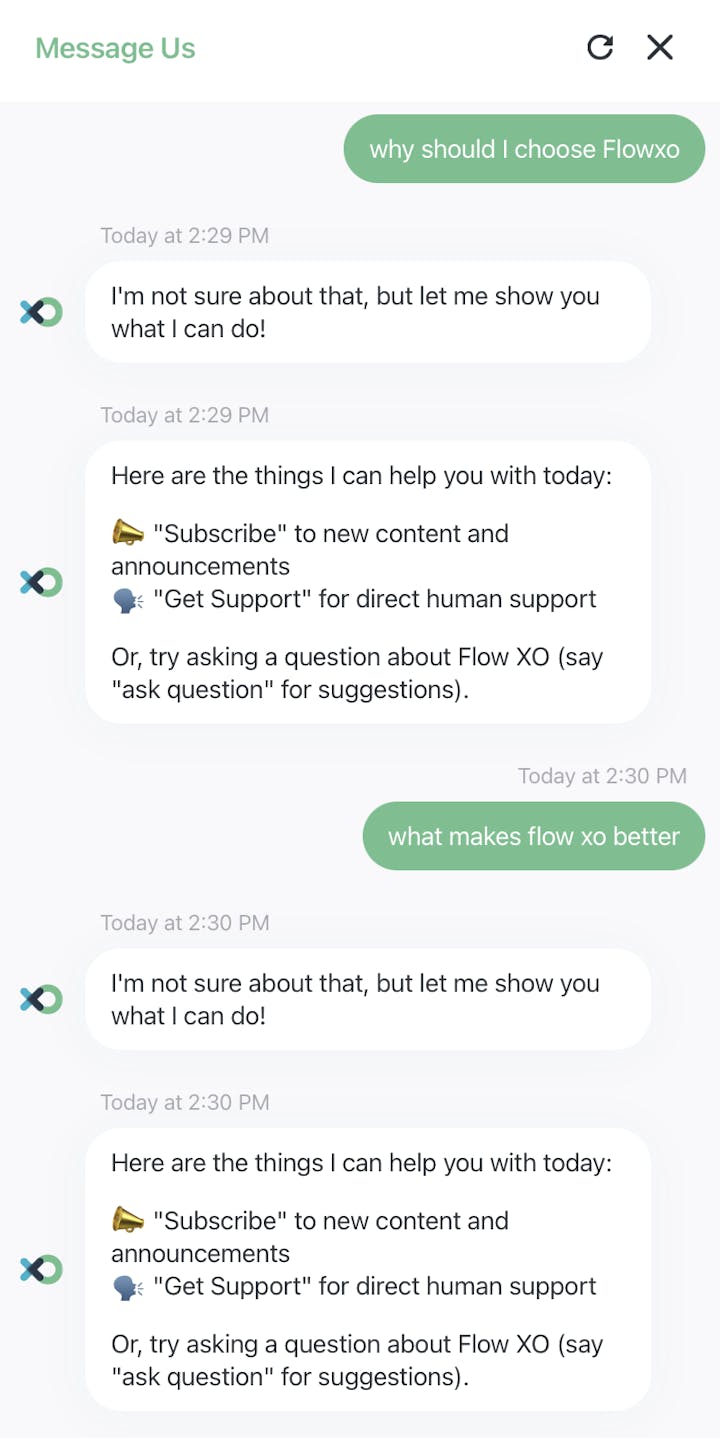Why You Don’t Need an AI Support Chatbot


Artificial intelligence (AI) shows incredible promise in 2021, but the experience of interacting with an AI chatbot is more like talking to a distracted toddler than it is to Tony Stark’s Jarvis. Still, using AI chatbots for customer service makes plenty of sense.
Perhaps you’ve read about recent AI breakthroughs, seen a compelling demo, or heard that your competition is installing an AI system. Whatever piqued your interest, there are some excellent reasons to consider using AI chatbots:
Handle more customer service requests without adding new staff members: If a growing customer base is putting pressure on your team, an easily scalable AI is a tempting option.
Use an automated conversational approach to encourage more customer self-service: Help customers find answers themselves by guiding them step by step to the right self-service options.
Extend support coverage across more hours with the same team: Chatbots aren’t bound by geography or time zones (and they only take a smoking break if things have really gone wrong).
Use a bot to collect more customer information upfront for your support team: Your human customer service team often spends the first few interactions with customers collecting basic information about the customer and their query. A chatbot could do that before your team even gets notified.
Give faster, more responsive customer service: An AI chatbot can talk to many people at once, something most humans struggle to do well beyond one or two chat conversations.
Save money that can be reinvested in your products and services: If chatbots can successfully handle a significant number of customer queries, some of your customer service budget could be directed back into core product improvements.
Enjoy rapidly-changing technology: AI and related fields are in an exciting period of rapid improvement. Being able to put it to use could be thrilling if you love to be an early adopter.
Those are all genuinely desirable benefits, and they could be valuable to your business. So is it time to set up your first AI chatbot and set it to work? Let’s first understand what an AI chatbot actually is.
This is a chapter in our Ultimate Guide to Live Chat Support. When you're ready, check out the other chapters:
Chapter 1 – Live Chat Support 101: Definition, Benefits, and Best Practices
Chapter 2 – Key Live Chat Statistics for Customer Service Teams
Chapter 3 – How to Implement Live Chat With a Small Support Team
Chapter 4 – The Big Benefits of Live Chat for Customer Service Teams
Chapter 5 – Important Live Chat Tips for Email Support Pros
Chapter 6 – Live Chat Examples for the Entire Customer Journey
Chapter 7 – The Best Live Chat Tools for Customer Support
Chapter 8 – 5 Reasons Why Every Ecommerce Store Needs Live Chat
Chapter 9 – Live Chat Best Practices and Common Mistakes
Chapter 10 – Why Contextual Support is Critical to Live Chat
Chapter 11 – Why You Don’t Need an AI Support Chatbot
Chapter 12 – Actionable Live Chat Metrics to Start Tracking Today
What are AI chatbots?
AI is an extremely broad field of study. Let’s start by distinguishing AI chatbots from their simpler incarnations.
The two main types of chatbots
Chatbots come in two main varieties: rules-based and AI-based.
1. Rules-based chatbots
Think of these chatbots as a type of decision tree or flowchart robot. You define a set of rules ahead of time, and the chatbot strictly follows those rules. The rules may be simple — for example “if the customer searched for ‘refund,’ show them this help document” — or much more complex.
Either way, all the rules and outcomes are 100% defined by the humans in charge. The bot will never do something other than what it was explicitly set up to do, which limits risk, but it also limits their ability to handle rarer scenarios.
2. AI-based chatbots
AI chatbots are not following a preset list of rules. Instead, they use natural language processing and machine learning to “understand” a customer’s question and independently determine the best answer. They are not pre-programmed with a set of questions and answers, but instead they learn on the job and can generate a brand-new reply to any question they are asked.
The promise of AI chatbots is compelling: a machine that can independently hold convincing, human-sounding conversations with multiple customers on any topic all at once.
There are some very impressive examples of AI chatbots in action that you may have already seen or even used, but there have also been some spectacular AI chatbot failures.
The reality of AI support chatbots in 2021
The market for AI-based tools is growing rapidly, and AI-based chatbots are one of the most common implementations for machine learning technology. Technology prognosticators have listed AI chatbots as the next big thing for years now, but what is the actual state of AI chatbots?
AI chatbots:
Are still early in their technological development. Letting AI chatbots talk to your customers today is a little like letting your four-year-old answer the phone. It might work fine, but if the conversation moves beyond their limited scope of knowledge, it’s probably going to go off the rails, and it's your caller who suffers.
Can create poor customer experiences. For most businesses, this is the crux of the issue. AI chatbots too often create more frustrating customer service experiences than either a simple rules-based bot or traditional help system. Consider this typical example:

Require a lot of ongoing training and maintenance. AI chatbots need a lot of skilled attention in order to function well and to improve (and entire AI training platforms have sprung up to provide this service). Don’t forget to factor that time and cost into your decision-making, especially if you don’t already have those skills on your team.
Don’t actually “know” anything. AI does not “understand” anything; it’s just really good at predicting the most statistically likely response. AI can produce impressively accurate answers, but it can also be wildly wrong, and it has no “common sense” to fall back on.
Perform best with constrained, simple, and common queries. AI chatbots can work really well, and reliably so, when dealing with simple, clear questions. Often those can be less expensively answered by a simple knowledge base article — or even a rules-based chatbot.
Are not popular with customers. In a recent survey of 1,000+ people, 60% said they did not trust chatbots to communicate their issues effectively. Your customer base and market space will vary, of course, but consumers are consistently wary of poor experiences from chatbots.
Can go really, terribly wrong. As in spouting racism and homophobia levels of wrongness. Normal hiring and QA practices are set up for humans, but by their nature, AI chatbots are working independently and will require a different sort of management.
Will all of these issues occur for every installation of an AI chatbot? Not at all. There are certainly companies successfully using AI chatbots right now to help their customers.
However, achieving that success involves a lot more cost, effort, and training than the AI hype would have you believe. Fortunately, there are other ways to get the same results with less expensive, more reliable tools you can implement today.
Get the benefits of an AI chatbot without all the downsides
The core promise of AI chatbots is more customers being helped more quickly, without adding all the complications and costs of having extra staff to deliver that service.
But while that promised perfection of AI has not yet arrived, tools like Help Scout’s Beacon can help you get there today. By combining an always-accessible help point with a flexible blend of contextual self-service, live chat, and messaging options, Beacon can transform your customer’s experience without exploding your budget.
1. Increase self-service rates without lowering customer satisfaction
Many customers will happily answer their own questions if your self-service options are high quality and readily accessible. Read Using Customer Self-Service to Deliver Better Support for some practical ideas on improving both your self-service adoption rates and quality.
A customer service widget can make that help much simpler to find and use. Help Scout’s Beacon can be set up to show relevant help documentation first while still letting your customer opt for human help if they prefer.
2. Show relevant contextual help
If someone has just browsed your pricing page and is now looking for help, you can make an educated guess about which topic they might need more information on. Yet too many companies drop their customers into their knowledge base main page, forcing the customer to hunt for the right document.
A tool like Beacon lets you offer informed, contextual help options. Define the most relevant knowledge base document for any given situation, and show it right on the same page, delivering a better customer experience and reducing the need for more support requests.

3. Gather useful information for your customer service team
Making your customer work to give you information you should already have is frustrating for the customer and time-consuming for your team.
Use technology like Beacon’s Identify method to keep track of information like which page a customer was on when they asked for help, where they had been before, what they had searched for, and what their previous support questions had been.
With all of that information on hand, your team can move more quickly to providing an informed solution.

4. Use data to improve your documentation
In most cases, you don’t need expensive AI tools to teach yourself how to deliver competent service. Built-in tools like Docs Reporting will help you identify parts of your knowledge base that need improving.
Use those reports to guide your changes and measure your success month to month as more customers are able to solve their own issues.

5. Proactively offer support when it is needed most
Your customer service team will know where customers are most likely to get stuck and where a timely suggestion can really help keep them on track. Proactively offering a useful video or an offer to chat can mean the difference between losing a customer and creating a new advocate for your business.
Help Scout’s Messages let you reach out to the right people at just the right moment. Offer targeted, highly efficient help that can be carefully crafted using all the knowledge and experience of your support and product teams.
6. Offer different support experiences to different customers
One reason AI chatbots can be appealing is that your support team can’t be everywhere at once. However, that may not be necessary: Customers (or potential customers) will often need more help at specific moments in their customer journey.
A good customer service tool can offer some people a self-service-led experience while others are offered live chat. Give your VIPs faster access to your team, or offer extra help to new customers as they onboard.
You can get more value from your existing customer service team without needing to scale up dramatically.
Nobody really wants to talk to a support chatbot
Unless you’re an AI tool maker, nobody is coming to you because they are excited about having a conversation with a robot. They have a specific problem or need, and they want it to be resolved as quickly and as easily as possible. The specific tool or technology that gets them that help is a much lower concern.
It is possible that some years from now an AI chatbot will be able to consistently deliver a really helpful customer experience, no matter how nuanced the problem is or how much the customer struggles to explain their issue.
Today, though, that chatbot experience just is not plausible — at least not without an enormous investment of time and money. But the good news is that you don’t need that AI to exist in order to deliver a significantly better customer service experience.
Using tools like Help Scout's Beacon can get you most of the benefits of today’s AI chatbots while giving your customers a higher, more reliable standard of care. And if the true promise of AI chatbots ever does come to pass, you will have a high-quality standard to measure them against.


